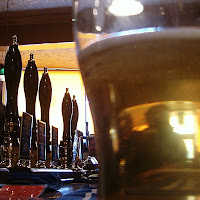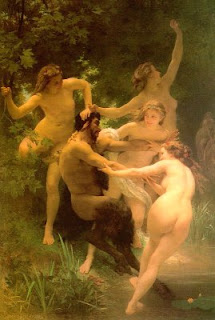





I've been hired to find the best fun in the world

 "A Buckinghamshire resident described the emptying of the commons after the suppression of Sunday recreations as a depressing loss. While formerly the common 'presented a lively and pleasing aspect, dotted with parties of cheerful lookers-on,' it was now 'left lonely and empty of loungers,' leaving the men and boys with nothing to do but hang out in the pubs and drink.(11)"
"A Buckinghamshire resident described the emptying of the commons after the suppression of Sunday recreations as a depressing loss. While formerly the common 'presented a lively and pleasing aspect, dotted with parties of cheerful lookers-on,' it was now 'left lonely and empty of loungers,' leaving the men and boys with nothing to do but hang out in the pubs and drink.(11)" "His mundane jurisdiction covered vinyards and wine, but his more spiritual responsibility was to preside over the orgeia (literally, rites performed in the forest at night, from which we derive the word orgy), where his devotees danced themselves into a state of trance.
"His mundane jurisdiction covered vinyards and wine, but his more spiritual responsibility was to preside over the orgeia (literally, rites performed in the forest at night, from which we derive the word orgy), where his devotees danced themselves into a state of trance. "The most notorious feminine form of Dionysian worship, the oreibaia, or winter dance, looks to modern eyes like a crude pantomime of feminist revolt. In mythical accounts, women "called by the god to participate drop their spinning and abandon their children to run outdoors and into the mountains, where they dress in fawn skins and engage in a 'frenzied dance.' These maenads, as Dionysus's female cult members were called, run through the woods calling out the name of the god, or uttering the characteristic bacchic cry 'euoi' they toss their hair and brandish their thyrsos - sticks to which pinecones have been attached. Finally, they achieve a state of mind the Greeks called enthousiasmos - literally, having the god within oneself - or what many cultures in our own time would call a "possession trance." These were not solely mythical events; in some times and places, the oreibasia was officially condoned and scheduled for every other year, in the dead of winter. Pausanias, who wrote in the second century CE, tells of a party of maenads who reached the eight-thousand foot summit of Mt Parnassus - an impressive athletic achievement, especially if performed in the winter - and Plutarch wrote of an occasion when a group of female worshippers were cut off by a snowstorm and had to be rescued."
"The most notorious feminine form of Dionysian worship, the oreibaia, or winter dance, looks to modern eyes like a crude pantomime of feminist revolt. In mythical accounts, women "called by the god to participate drop their spinning and abandon their children to run outdoors and into the mountains, where they dress in fawn skins and engage in a 'frenzied dance.' These maenads, as Dionysus's female cult members were called, run through the woods calling out the name of the god, or uttering the characteristic bacchic cry 'euoi' they toss their hair and brandish their thyrsos - sticks to which pinecones have been attached. Finally, they achieve a state of mind the Greeks called enthousiasmos - literally, having the god within oneself - or what many cultures in our own time would call a "possession trance." These were not solely mythical events; in some times and places, the oreibasia was officially condoned and scheduled for every other year, in the dead of winter. Pausanias, who wrote in the second century CE, tells of a party of maenads who reached the eight-thousand foot summit of Mt Parnassus - an impressive athletic achievement, especially if performed in the winter - and Plutarch wrote of an occasion when a group of female worshippers were cut off by a snowstorm and had to be rescued."In ancient times and in traditional cultures, dance has functioned as the means by which people gathered and unified themselves in order to confront the challenges of their existence. When the members of some hunting cultures need food, they dance a hunting dance, preparing themselves for the rigors of the hunt and supplicating the divinities and the animal spirits to bless their undertaking. Often the dancers enact the whole ritual of the hunt, bringing it to a successful conclusion."
 The clown intervenes spontaneously in the Native American community whenever she sees fit. Clowns don’t answer to anyone in the community, they answer to up there, Han says pointing. If a clown starts to get all egotistic about that, other clowns will clown on them to bring them back down to size, keeping the community in balance. They do it all with a really light playful touch, concealing private learning kindly within a lot of laughter.
The clown intervenes spontaneously in the Native American community whenever she sees fit. Clowns don’t answer to anyone in the community, they answer to up there, Han says pointing. If a clown starts to get all egotistic about that, other clowns will clown on them to bring them back down to size, keeping the community in balance. They do it all with a really light playful touch, concealing private learning kindly within a lot of laughter.Wanted to tell you about amazing playtime I had last week, in the sea, at St David's (Whitesands Beach) - we went there for a couple of days and I bodyboarded as much as I could on a rubbishy foam kids board but that didn't matter - it was amazing! I absolutely LOVE it - get such a rush from being in the elements, wind rain waves - tossed about by the waves, waiting waiting waiting to catch one trying failing trying small whoosh paddling back out trying and GETTING THE WAVE!!! and just LOVING the sense of riding it, the pleasure of catching it... it was FAB. I think the seaside is a GREAT place for play. We also played football loads, with a ball so light the wind blew it into one goal all the time; and flew kites, and dug sandcastles. Sandcastle building, right on the shore as the tide comes in, is one of the types of play my kids get most involved and lost in, totally absorbed and delighted by their battle with the elements

 “There is a strong positive link between brain size and playfulness for mammals in general,” reported Neuroscientist Sergio Pellis, neuroscientist Andrew Iwaniuk and biologist John Nelson. (p33)
“There is a strong positive link between brain size and playfulness for mammals in general,” reported Neuroscientist Sergio Pellis, neuroscientist Andrew Iwaniuk and biologist John Nelson. (p33)